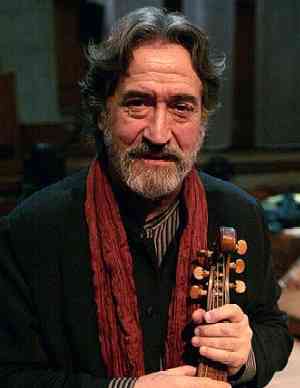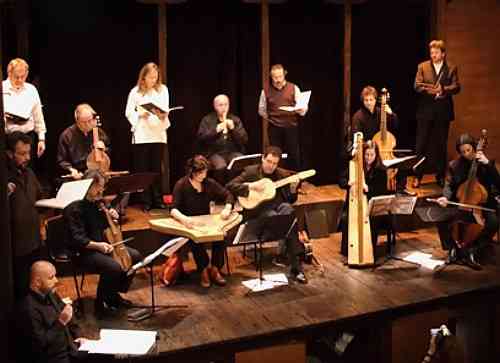Classical Music Review: Jordi Savall — Rock Star of Early Music
Considered by some to be a guardian of ancient music, Jordi Savall has inspired adulation for a variety of reasons, but in the end, it’s because he plays the viol or viola da gamba better than just about anyone else alive.
By Susan Miron
Jordi Savall packed Jordan Hall Friday night, as he does every time he plays here. I am still reeling from witnessing a feeding frenzy when his CDs were on sale at intermission during the Boston Early Music Festival a year ago in June—normally tame concertgoers were throwing money and pushing each other aside to ensure they’d get the CDs of their choice.
Considered by some to be a guardian of ancient music, Savall has inspired this kind of adulation for a variety of reasons, but in the end, it’s because he plays the viol or viola da gamba better than just about anyone else alive.
Entitled “Musical Europe: The Golden Age of the Consort Music for Viols (1500-1700),” Friday’s concert (the second this season sponsored by The Boston Early Music Festival) featured Jordi Savall and his Hespèrion XXI, a group he leads (along with La Capella Reial and Le Concert de Nation). Founded in 1974 by Jordi Savalle, his late wife, the singer Montserrat Fugueras, and two other colleagues, this ensemble (previously known as Hespèrion XX) has, in their words, “rescued numerous works from oblivion, thus contributing to a major reappraisal of the fundamental aspects of the Medieval, Renaissance, and Baroque repertoires.”
Now 70, Jordi Savall has a musical career as multifaceted and successful as anyone in the music business. He has recorded over 170 CDs, and his acclaimed career as performer (140 concerts a year), teacher, researcher, and creator of new musical and cultural projects would be daunting for someone half his age. Clearly, the mission of proving that early music need not be elitist is garnering plenty of recognition; Savall was won innumerable awards and honors. His concerts are early music love-ins.
For this concert, Savall divided the program into six sections (as he often does on his many CDs), offering a panorama of music for viols from Italy (Dances of the Renaissance), Renaissance England (the great John Dowland and Anthony Holborne), Spanish Dances, France (Music for King Louis XIII), and Germany (the music of Samuel Scheidt). The final section introduced European Baroque Music from each of the five countries. The program notes explain that the viol consort (a family of viols that Savall played) range from soprano and alto to tenor, bass viol, and violone, the latter a really low bass viol. The instruments served in the late Renaissance as “more than just a means of entertainment. . .The process of group music making . . . reflected the construction of Renaissance society. . . The consort functioned as a microcosm of the social ideals of the Renaissance Humanism.”
While the viol might have Spanish origins, under Italian patronage the viol consort won out over wind ensembles as a vehicle for upper-class music making. Popular dance and song worked well for this consort music, which is more restrained in volume than, say, a modern string quartet with similar voicing. The program was exceptionally well organized, like a quick seminar deftly introducing the different styles and sounds of the various countries.
Unlike string quartets, in which interdependence is interwoven with solo material, in these viol consorts, the treble viol—Savall—is the leader, getting as many virtuoso displays as he wants while the others play the part of his subservient soldiers.
In addition to the bowed strings (Philippe Pierlot, alto and bass viol; Sergi Casademunt, tenor viol; Carol Lewis, bass viol; Xavier Puertas, violone), there was Xavier Díaz-Latorre, who played viheula, an ancestor of the guitar and the theorbo, and David Mayoral, who played percussion (including two short, brown, wooden sticks and little, jingly bells whose name I wish I knew) and without whom this concert would have been far less exciting.
One of this ensemble’s most extraordinary accomplishments is their ability to make diminuendos so subtly and gradually that their sound dwindles into nothingness; the music seems to be continuing to sound in some cosmic space. Savall plays with great warmth, musical elegance, and such virtuosity that at times my jaw just dropped. His ensemble is superb as well. They should have been introduced, along with their instruments, as Savall had done in previous concerts. It just takes a minute or two, and then people don’t wonder who is playing what or what a violone is. Nor were there even short bios for the performers These were really excellent players and deserved more acknowledgment.
In his pre-concert talk, full of mystical speculations, Savall said the following about memory, “We only remember the things that have touched us.” When we hear a truly great performer like him, we are not just touched, but for a moment, transported. Who would want to forget these moments?



[…] to purchase it, even if I don’t get to watch everything, to support the festival. We saw Jordi Savall in 2012 and I think I probably paid that much for 2 tickets (totally worth […]